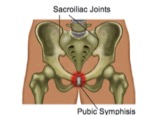What is Osteitis Pubis?
Osteitis Pubis is a medical term used to describe sports-related groin pain. Osteitis means ‘bone inflammation’, while pubis refers to the specific bone that is affected: the pubic bone. Osteitis pubis is usually an overuse injury that can sometimes be triggered by a specific event. It is characterized by pain deep within the front of the pubic bone, caused by inflammation. The area of the pubic bone affected is specifically known as the ‘pubic symphisis’.
This type of injury is common in load-bearing athletes such as runners. Other people commonly affected include soccer players and footballers, due to their frequent kicking actions.
How does it happen?
Instability within the pelvic region is the primary cause of Osteitis Pubis, particularly if the instability occurs at the connection between the two sides of the pubic bones at the front of the body. The pelvis carries the weight of the upper body and is responsible for providing stability when walking, running and kicking. This means that the joint can easily become irritated and inflamed.
What are the signs and symptoms of Osteitis Pubis?
Osteitis pubis is aggravated by weight-bearing activities, with running and kicking being the two main culprits. Pain is usually experienced on one side, however both sides can be affected. The pain is usually located at the front of the pelvis, and may progress into the hip and groin area as it becomes more severe.
Sufferers of Osteitis Pubis tend to have a history of previous groin strain, as well as lower back pain. They may also have a history of a sports hernia in the hip area. As with most inflammatory conditions, the pain may be worse when in use, better when resting, and worse overnight into the morning.
How can Physio help?
Your physio is able to help this condition in a number of ways and will hopefully get you back to your pre injury sporting level. During assessment, your physio will look at many different things to determine the cause of the condition. Muscle length, muscle strength and muscle control will all be assessed. Your posture in standing, walking and running will also be assessed to determine any irregularities.
Your physio will ask you to rest from sport for a period of time to allow some bony healing to occur. They will then progress you through a rehab program aimed at getting you back to sport.
This rehab program will retrain your muscles to stabilize the pelvis when walking, running and kicking. The muscles will also need to have relatively equal flexibility to help stabilize the pelvis. Your physio will give you specific exercises to target the strength and flexibility of these muscles. Finally, your physio will progress you to running or kicking, and allow you to gradually return to sport over a 3-to-6-month period of time.
The information in this blog is not a replacement for proper medical advice. Always see a medical professional for assessment of your individual condition.

